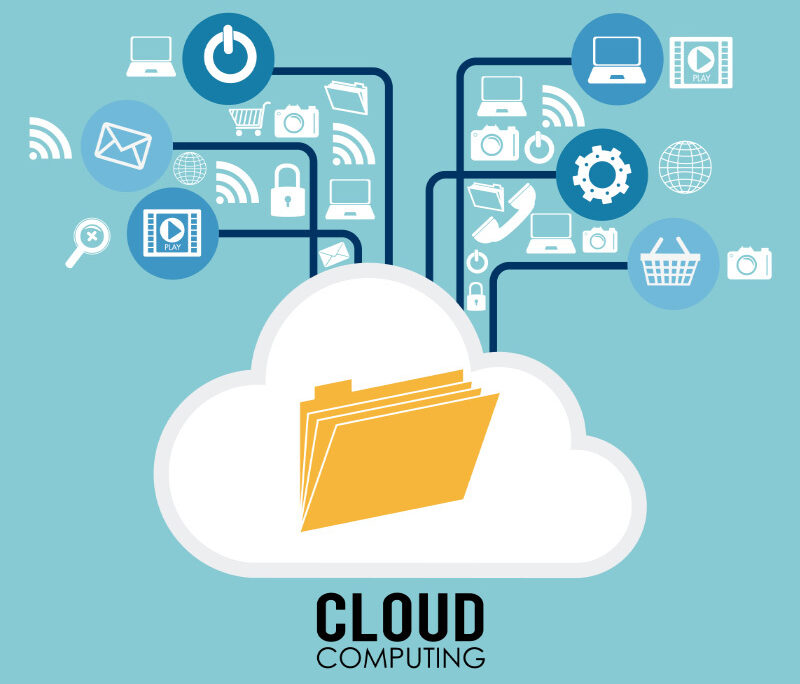Cloud Computing: A Transformational Technical Revolution
Technology
Published on 28-08-2023

In this Digital era, where consistent and ordered access to resources and data-driven decisions are paramount, cloud computing has emerged as a game changer. Cloud computing has revolutionized how businesses and individuals manage, store, and access data, applications, and services.
Understanding Cloud Computing:
Cloud Computing is generally about applications and services run on a distributed network using virtualized resources that common internet protocols and networking standards can access. The notion that resources are virtual and limitless distinguishes it, and details of the physical systems on which software runs are abstracted from the user.
Taking the technology, services, and applications akin to those on the Internet, cloud computing transforms them into a self-service utility. The term ‘cloud’ encompasses two fundamental concepts:
- Abstraction: Abstracting the details of system implementation from users and developers, cloud computing leads to applications running on unspecified physical systems, data being stored in unknown locations, systems administration being outsourced to others, and ubiquitous access by users.
- Virtualization: Cloud computing allows provisioning systems and storage based on requirements from a centralized infrastructure by virtualizing systems through pooling and sharing resources. Costs are calculated on a metered basis, enabling multitenancy while ensuring scalability and agility of resources.
Need HELP?
Consult with Expert Now
Cloud Types and Models
To better describe cloud computing, several cloud types have been defined. The two basic types are Deployment models and Service models.
- Deployment models: These models refer to the location and management of the cloud’s infrastructure.
- Service models: This consists of the particular types of services that you can access on a cloud computing platform.

The US National Institute of Standards and Technology (NIST) has established working definitions that categorize cloud computing into service and deployment models. Initially, the NIST model did not mandate virtualization for resource pooling in clouds, nor did it explicitly necessitate multi-tenancy in the early definitions of cloud computing. Multi-tenancy, which involves sharing resources among multiple clients, was optional. In the most recent iteration of the NIST definition, virtualization and multi-tenancy support are now essential for cloud computing networks.

The Jericho Forum develops the Cloud Cube Model (CCM) in cloud computing. This model helps to classify the network into four-dimensional parts as follows:
- Internal/External
- Insourced/Outsourced
- Proprietary/Open
- Parameterized/de-parameterized
The Cloud Cube Model’s primary emphasis is enhancing cloud networks’ security. This model aids various organizations, IT managers, and business leaders in establishing a secure cloud network through its framework. Security holds significant importance for diverse cloud users within cloud computing. The Cloud Cube Model also facilitates secure collaboration among cloud architectures, benefiting various organizations and businesses.

Deployment Models
Deployment models define the cloud’s purpose and its location. According to the NIST definition, there are four deployment models:
- Public cloud: This infrastructure is available to the public or a large industry group and is owned by a cloud service provider.
- Private cloud: Operated exclusively for a single organization, the organization or a third party can manage it. Private clouds can be on- or off-premises.
- Hybrid cloud: Combining multiple clouds (private, public, or community), a hybrid cloud maintains distinct identities while functioning as a unified entity. It may provide standardized or proprietary data access and application portability.
- Community cloud: Organized to serve a common purpose, a community cloud could be for one or multiple organizations that share concerns such as mission, policies, security, and regulatory compliance. The constituent organization(s) or a third party can manage management.
Service Models
The deployment model highlights various types of clouds that represent the way infrastructure is deployed. The cloud is the demarcation between the end of a client’s network, management, and responsibilities and the beginning of the cloud service provider’s domain. With the evolution of cloud computing, different vendors provide clouds with distinct associated services. This array of services introduces another layer of definitions known as the service model.
Numerous service models have been detailed in the literature, all following the format of “XaaS,” which stands for “as a Service.”
Three service types have been universally accepted:
- Infrastructure as a Service: IaaS provides virtual machines, virtual storage, virtual infrastructure, and other hardware assets as resources that clients can provision. The responsibility for managing all infrastructure lies with the IaaS service provider, whereas the client assumes ownership of all other facets of the deployment. This can include the operating system, applications, and user interactions with the system.
- Platform as a Service: PaaS offers virtual machines, operating systems, applications, services, development frameworks, transactions, and control structures. Clients can deploy their applications on the cloud infrastructure or utilize applications programmed with languages and tools supported by the PaaS service provider. The service provider takes care of cloud infrastructure, operating systems, and enabling software management. The client is responsible for installing and managing the application it is deploying.
- Software as a Service: SaaS encompasses a comprehensive operational environment featuring applications, management, and user interface. Within the SaaS model, the client receives the application via a lightweight client interface (typically a browser), and the client’s responsibilities are limited to inputting, maintaining its data, and managing user interaction. The vendor assumes responsibility for everything from the application to the underlying infrastructure.

The three different service models taken together have come to be known as the SPI model of cloud computing. Many other service models have been mentioned: Storage as a Service (StaaS), Identity as a Service (IDaaS), Compliance as a Service (CaaS), and so forth. However, the SPI services encompass all the other possibilities.
Service Models | Examples |
Infrastructure as a Service (IaaS) | Amazon Elastic Compute Cloud (EC2), Eucalyptus, GoGrid, FlexiScale, Linode, RackSpace Cloud, Terremark |
Platform as a Service (PaaS) | Force.com, GoGrid CloudCenter, Google AppEngine, Windows Azure Platform |
Software as a Service (SaaS) | GoogleApps, Oracle on Demand, SalesForce.com, SQL Azure |
Benefits of Cloud Computing
- On-demand self-service: Through on-demand self-service, clients can provision computer resources without needing to engage with personnel from the cloud service provider.
- Broad network access: Resources within the cloud are accessible over the network through standard methods, providing platform-independent access to various types of clients. This encompasses diverse operating systems and devices like laptops, mobile phones, and PDAs.
- Resource pooling: Cloud service providers aggregate resources into a pool that supports multi-tenant utilization. Physical and virtual systems are dynamically allocated or reallocated as needed. An essential element of pooling is abstraction, concealing the location of resources like virtual machines, processing power, memory, storage, and network connectivity.
- Rapid elasticity: Resources can be rapidly and flexibly provisioned. Scaling can involve either augmenting system power (scaling up with more robust computers) or expanding system size (scaling out with more computers of the same type). Scaling can be either automatic or manual. The client believes cloud computing resources should appear limitless and purchasable at any time and quantity.
- Measured service: The use of cloud resources is measured, audited, and reported to the customer based on metered usage. Clients might be charged based on various metrics, such as storage consumption, transaction volume, network I/O, bandwidth usage, processing capacity utilized, etc. Billing is correlated with the extent of services provided.

While these five core features of cloud computing are on almost anybody’s list, we should also consider these additional advantages:
- Lower costs: Because cloud networks operate at higher efficiencies and with greater utilization, significant cost reductions are often encountered.
- Ease of utilization: Depending upon the type of service being offered, we may not require hardware or software licenses to implement your service.
- Quality of Service: The Quality of Service (QoS) is something that we can obtain under contract from our vendor.
- Reliability: The scale of cloud computing networks and their ability to provide load balancing and failover makes them highly reliable, often much more reliable than what you can achieve in a single organization.
- Outsourced IT management: A cloud computing deployment lets someone else manage your computing infrastructure while you manage your business. In most instances, you achieve considerable reductions in IT staffing costs.
- Simplified maintenance and upgrade: We can easily apply patches and upgrades because the system is centralized. This means our users always have access to the latest software versions.
- Low Barrier to Entry: Upfront capital expenditures are dramatically reduced. In cloud computing, anyone can be a giant at any time.
Although there are many benefits, cloud computing has a few disadvantages, too.
- As cloud infrastructure is completely owned, managed, and monitored by service providers, cloud users have less control over the function and execution of services within a cloud infrastructure.
- Every data is stored in the cloud, and we access these through the cloud by using the internet connection. Thus, it depends on good internet connectivity, or we cannot access these data.
- Vendor lock-in is the most significant disadvantage where organizations face troubles from one vendor to another as different vendors provide different platforms.

Cloud computing has enormously impacted various industries, primarily the IT and Software Development industry. It is widely used in the healthcare industry, where patient data is stored. Students and educators can collaborate on projects, access resources, and participate in virtual classrooms with the help of this technology. Cloud-based financial tools offer enhanced security and compliance features in the finance industry. E-commerce businesses use cloud-based inventory management to improve their supply chain efficiency.
Cloud Computing has undeniably reshaped the technological landscape, empowering businesses and individuals alike to harness the potential of computing resources without physical infrastructure limitations.
As technology continues to evolve, addressing security concerns and optimizing cloud strategies will be pivotal in maximizing the benefits of this transformative force. Whether in IT, healthcare, education, finance, or retail, the cloud’s impact is far-reaching and promises to drive innovation for years.














